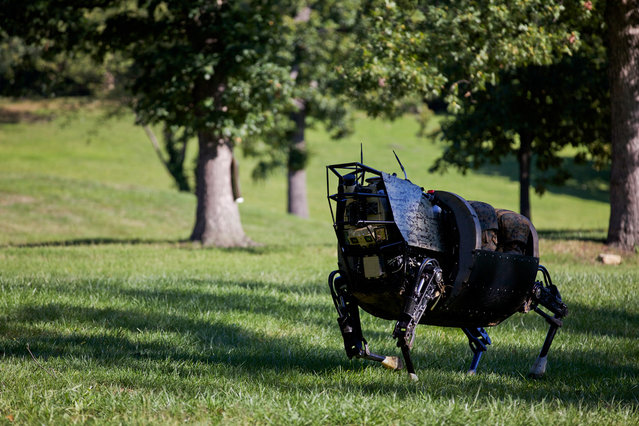
Resembling a headless horse, a robotic Legged Squad Support System (LS3) developed by the Defense Advanced Research Projects Agency navigates terrain during a demonstration at Joint Base Myer-Henderson Hall, Fort Myer, Virginia, on September 10, 2012. The LS3 is being developed for use by the U.S. military to carry heavy loads and equipment over a variety of terrain. (Photo by Sgt. Mallory S. VanderSchans/USMC via The Atlantic)
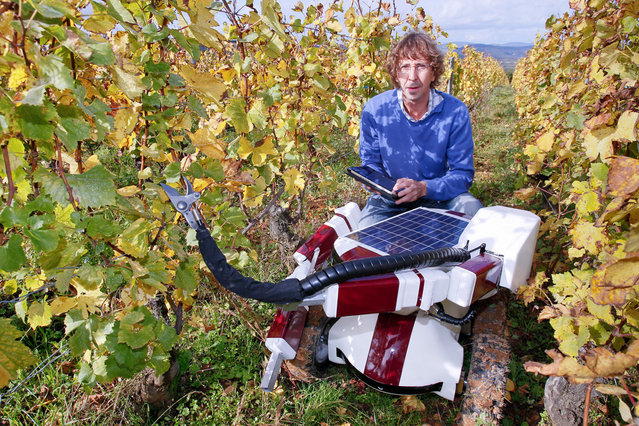
French engineer Christophe Millot stands with his Wall-Ye prototype, a robot designed to prune vines, in the Pouilly Fuisse vineyard during a press presentation near Macon, France, on October 12, 2012. The 50 by 60 centimeter robot, with four wheels and two metal arms, has six web cameras and a GPS and can roll between grapevines, test the soil and check the grapes. With a little more training, Wall-Ye will be able to prune up to 600 vines per day, says his inventor, who has been working on the project for the past three years. (Photo by Robert Pratta/Reuters via The Atlantic)

A free-swimming robot submarine, manoeuvres beneath sea ice in Eastern Antarctica in this undated handout picture made available on October 11, 2012. Scientists have produced the first three dimensional map of the surface beneath Antarctic sea ice, helping them better understand the impact of climate change on Antarctica. The team of scientists from eight countries have used a robot submarine to chart a frozen and inverted world of mountains and valleys, allowing accurate measurements of the crucial thickness of Antarctic sea ice. (Photo by Australian Antarctic Division/Reuters via The Atlantic)
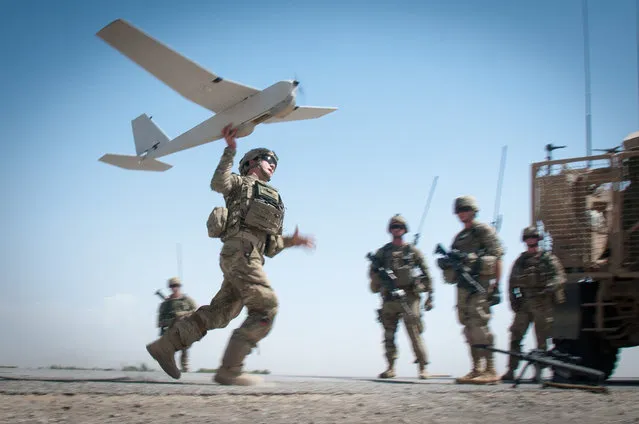
U.S. Army Chief Warrant Officer 2 Dylan Ferguson, a brigade aviation element officer with the 82nd Airborne Division's 1st Brigade Combat Team, launches a Puma unmanned aerial vehicle June 25, 2012, Ghazni Province, Afghanistan. Ferguson uses the Puma for reconnaissance for troops on the ground. (U.S. Army photo by Sgt. Michael J. MacLeod, Task Force 1-82 PAO via The Atlantic)
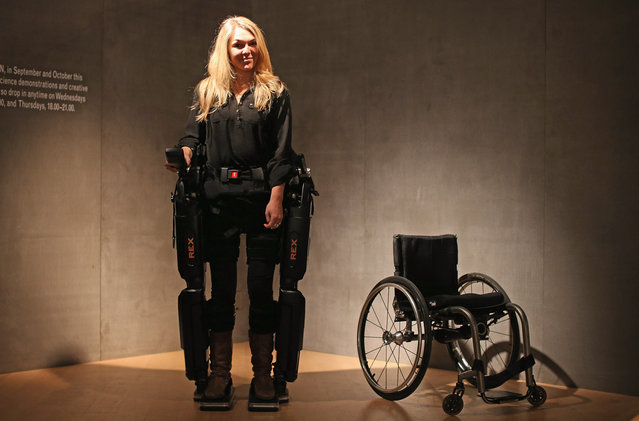
Sophie Morgan walks with the aid of "Rex", a Robotic Exoskeleton at the Welcome Trust on September 19, 2012 in London, England. The system allows wheelchair users including fully paralyzed people, to stand upright and walk independently. Sophie was paralyzed from the breast bone down in 2003 following a car accident. (Photo by Dan Kitwood via The Atlantic)

On Mars, NASA's Curiosity rover images itself – this image shows the rover's Alpha Particle X-Ray Spectrometer (APXS), with the Martian landscape in the background. The image was taken by Curiosity's Mast Camera on the 32nd Martian day, or sol, of operations on the surface (September 7, 2012). APXS can be seen in the middle of the picture. This image let researchers know that the APXS instrument had not become caked with dust during Curiosity's dusty landing. Scientists enhanced the color in this version to show the Martian scene as it would appear under the lighting conditions we have on Earth, which helps in analyzing the terrain. (Photo by NASA/JPL-Caltech/MSSS via The Atlantic)
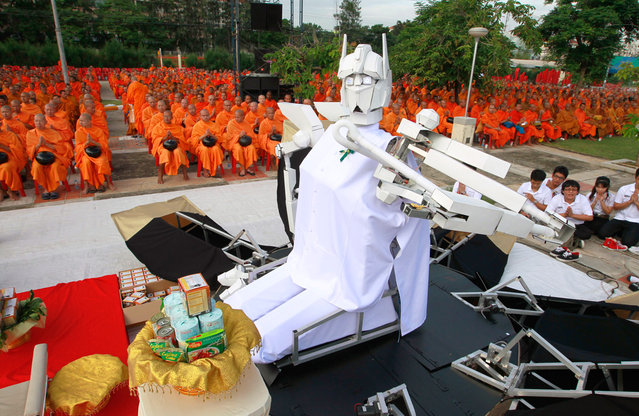
A robot sits before Buddhist monks, as they pray during a mass alms-offering ceremony at King Mongkut's Institute of Technology Ladkrabang in Bangkok, on June 19, 2012. The ceremony was held to mark the 2,600th anniversary of the enlightenment of Lord Buddha. (Photo by Sukree Sukplang/Reuters via The Atlantic)
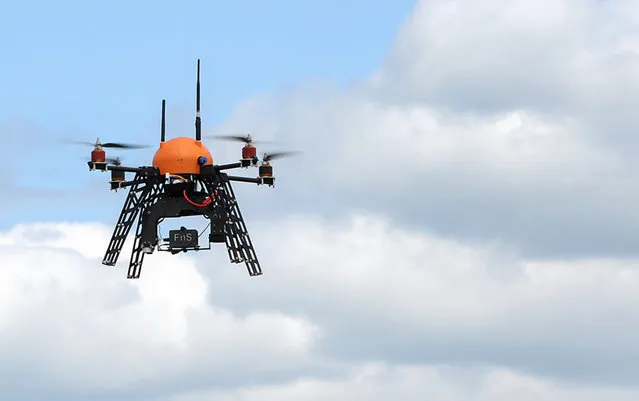
An unmanned aerial vehicle (UAV), or drone, made by the French company Fly-n-Sense, flies over Mont-de-Marsan, France, on July 12, 2012. French firefighters were testing it in the Landes forest region as an innovative forest surveillance system which will enable a real-time monitoring of fire outbreaks. (Photo by Pierre Andriew/AFP Photo via The Atlantic)
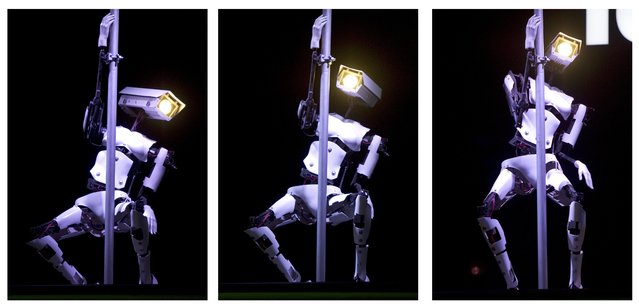
A series of three pictures shows a pole dancing robot at the Tobit Software booth prior to the opening of the CeBIT IT fair in Hanover, Germany, on March 5, 2012. (Photo by Odd Andersen/AFP Photo via The Atlantic)
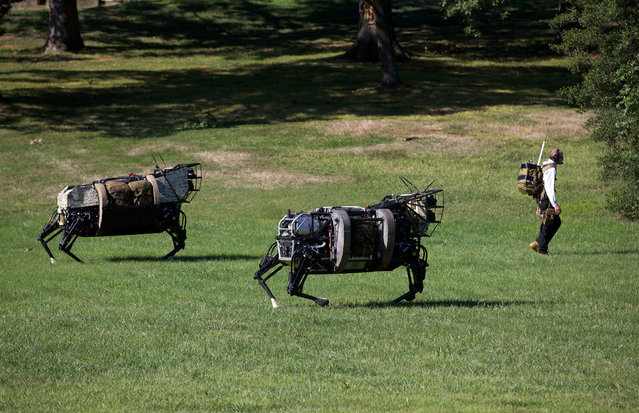
Two robotic legged squad support system (LS3) machines by the Defense Advanced Research Project Agency follow a technician during a demonstration at Joint Base Myer-Henderson Hall, Virginia, on September 10, 2012. (U.S. Marine Corps photo by Sgt. Mallory S. VanderSchans via The Atlantic)
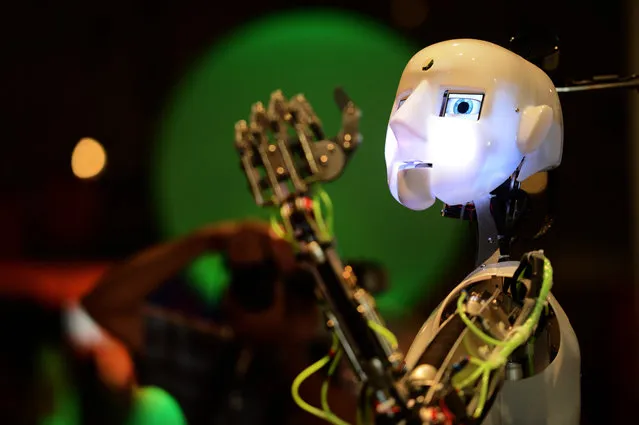
A robot gestures at the Ideen Park fair in Essen, Germany, on August 13, 2012. The fair is organized for children and young adults by the German steel company ThyssenKrupp AG to inspire their spirit of research and to promote careers in science and technology. (Photo by Patrik Stollarz/AFP Photo via The Atlantic)
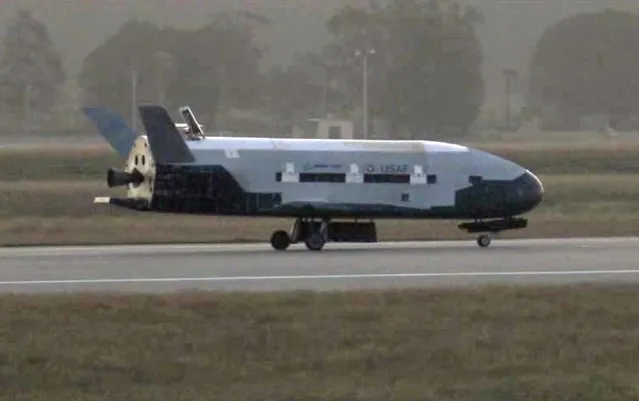
This image from video made available by the Vandenberg Air Force Base shows the X-37B unmanned spacecraft landing at Vandenberg Air Force Base, on June 16, 2012. The spacecraft, which was launched from Cape Canaveral Air Force Station in Florida in March 2011, conducted in-orbit experiments during a 15-month clandestine mission, officials said. It was the second such autonomous landing at the base. (Photo by AP Photo/Vandenberg Air Force Base via The Atlantic)
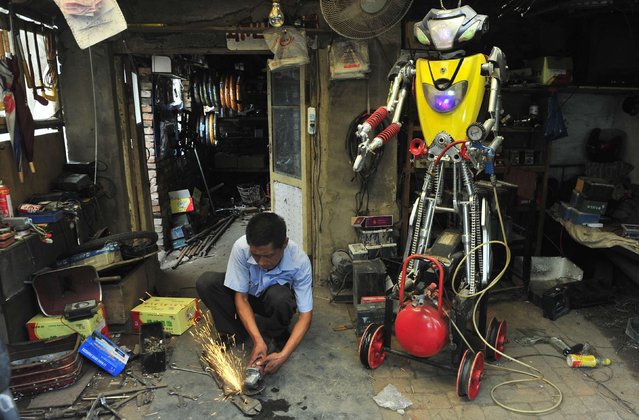
A 49-year-old electric bike mechanic who identified himself only as Wu welds a component to fit onto his newly-made robot (R) at his repair shop in Shenyang, Liaoning province June 25, 2012. Wu spent over 10 days to make this nearly two-meter high robot using parts from abandoned electric bikes. The robot, which is able to walk and pump up tires by itself, is still under modification, according to local media. (Photo by Reuters/Stringer via The Atlantic)
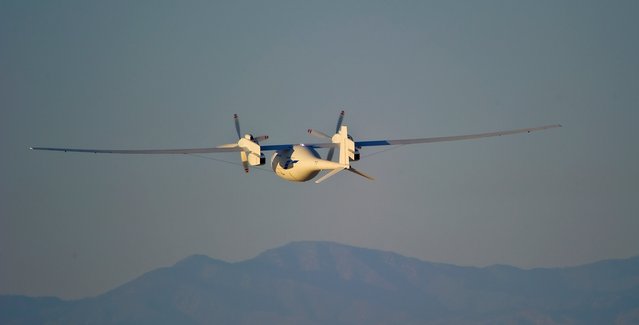
The new Boeing Phantom Eye unmanned drone, designed to stay airborne for days, travels on its first autonomous flight at the NASA Dryden Flight Research Center at Edwards Air Force Base, California, on June 1, 2012. The 28-minute flight began at 6:22 a.m. PDT as the liquid-hydrogen powered aircraft lifted off its launch cart. Phantom Eye climbed to an altitude of 4,080 feet and reached a cruising speed of 62 knots. (Photo by Robert Ferguson/AP Photo/Boeing via The Atlantic)
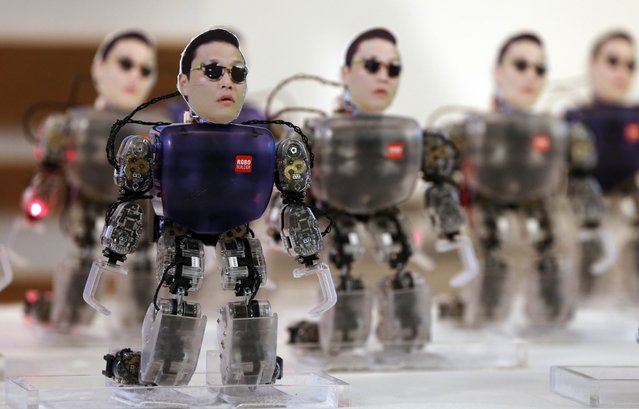
Robots carrying the face of South Korean rapper Psy dance during a ceremony to promote South Korea's robot industry in Seoul on October 17, 2012. The 34-year-old Psy has rocketed to international fame with his song “Gangnam Style” and its much-imitated dance moves which has gone viral on YouTube. (Photo by Yonhap, Park Dong-joo/AP Photo via The Atlantic)
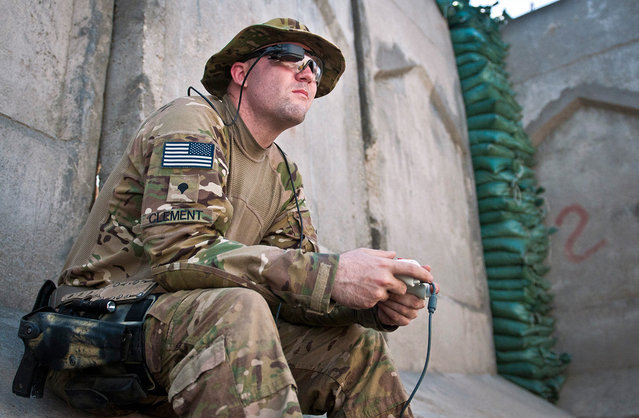
U.S. Army Spc. Andrew B. Clement, an explosive ordnance disposal technician assigned to 129th EOD, attached to 3rd Brigade Combat Team, 25th Infantry Division, Task Force Bronco, uses an Xbox controller and a computer viewfinder to maneuver an EOD robot at Combat Outpost Honaker-Miracle in eastern Afghanistan's Kunar province, on August 1, 2012. (Photo by Sgt. 1st Class Mark Burrell/U.S. Army via The Atlantic)
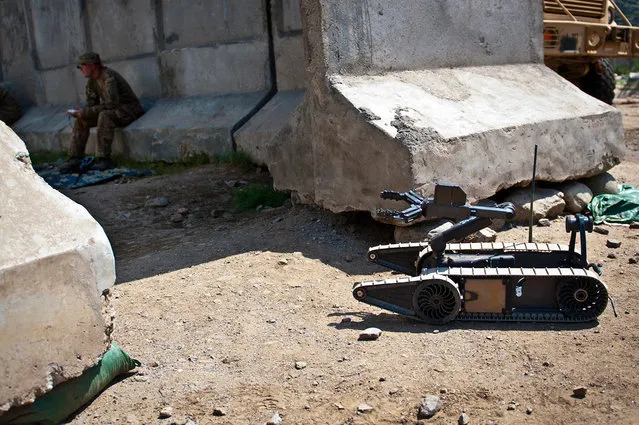
A Pacbot 310, an explosive ordnance disposal robot, turns the corner as U.S. Army Spc. Andrew B. Clement, an EOD technician from Jackson, Tennessee, practices maneuvering it at Combat Outpost Honaker-Miracle in eastern Afghanistan, on August 1, 2012. (Photo by Sgt. 1st Class Mark Burrell/U.S. Army via The Atlantic)
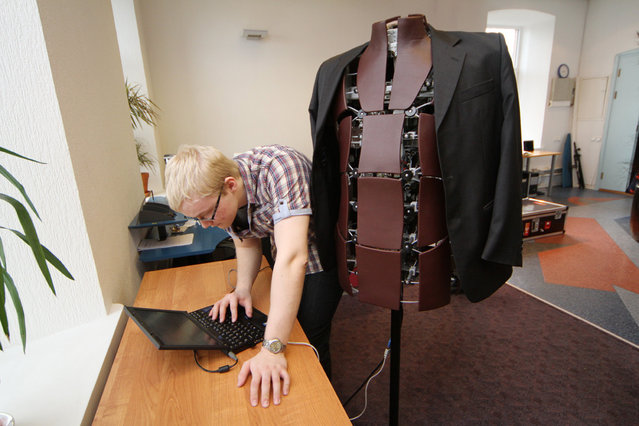
Lauri Mihkels from the technical support team of the Estonian company Fits.me adjusts a shape-shifting robotic mannequin on March 27, 2012 at offices in Tallinn. Fashion fans have one more reason to swap brick-and-mortar shops for online retailers after an Estonian company has come up with a technology allowing them to virtually try their clothes on. Using shape-shifting robotic mannequins, who can grow from slim to muscular in moments, and a technology invented by Estonian universities, the Fits.me company also spares online shops from heaps of returned goods. The robots can take on about 100,000 different body shapes, but only about 2,000 are being used for commercial purposes. (Photo by Priit Simson/AFP Photo via The Atlantic)
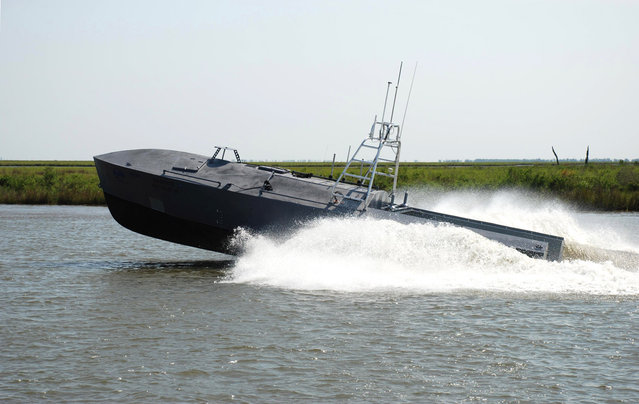
Defense contractor Textron Inc. demonstrates what it calls its Common Unmanned Surface Vessel (CUSV) technology at the company's New Orleans shipyard, on April 12, 2012. Technology that sent unmanned aircraft over warzones in Iraq and Afghanistan soon could be steering unstaffed boats for such dangerous tasks as minesweeping, submarine detection, intelligence gathering and approaching hostile vessels. (Photo by AP Photo/Textron, Inc. via The Atlantic)
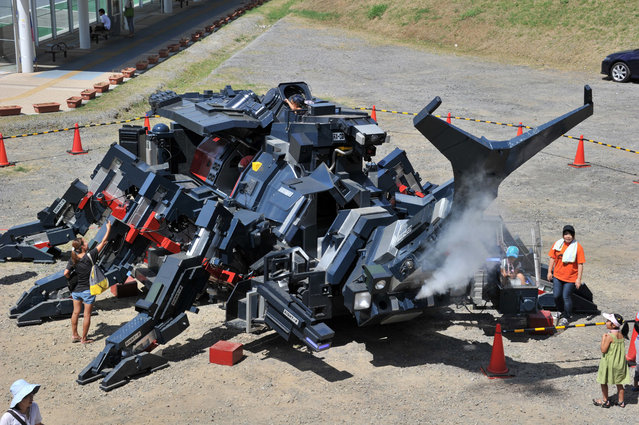
A large beetle-shaped robot “Kabutom RX-03”, produced by a Japanese engineer Hitoshi Takahashi is displayed before public at the Tsukuba Festival at Tsukuba city, Tokyo, on August 26, 2012. The Kabutom, 11-meters in length and weighing 17-tons, can walk with its six legs, powered by diesel engines and can blow smoke from its nose. (Photo by Yoshikazu Tsuno/AFP Photo via The Atlantic)
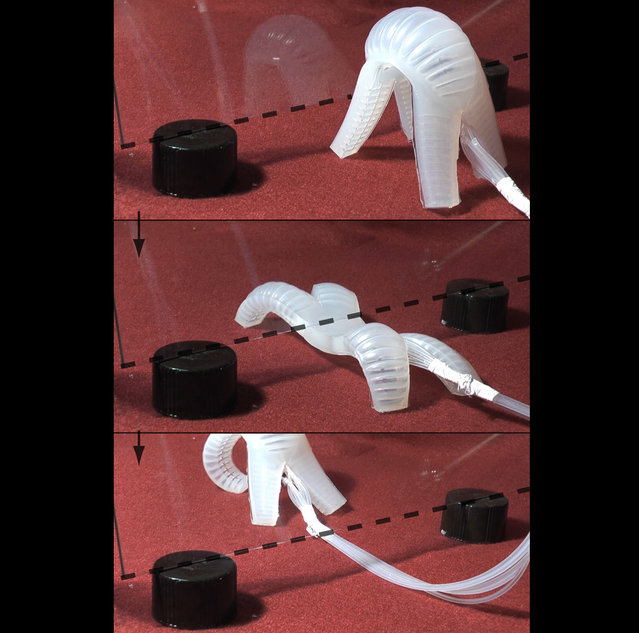
A soft-bodied robot navigates, from top to bottom, an obstacle course. Harvard University researchers built this flexible prototype robot that can crawl and move in a wavelike motion. Unlike rigid robots, soft robots can be used to squeeze into tight spaces. (Photo by Harvard University, Robert ShepherdAP Photo via The Atlantic)
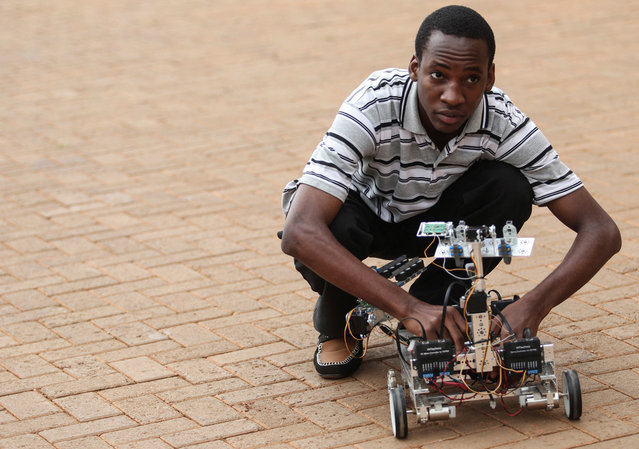
Alvin Kabwama, one of the designers of a prototype robot that can detect and disarm Improvised Explosive Devices attempts to switch it on at Makerere University's College of Engineering, Design Art and Telecommunication in Kampala, Uganda, on June 6, 2012. The robot is remotely controlled by a computer and can navigate a flat surface of up to a 20m radius. The development comes in the wake of continuous terrorist threats as a result of the country's contribution of forces to the African Union peace keeping mission in Somalia. (Photo by Edward Echwalu/Reuters via The Atlantic)
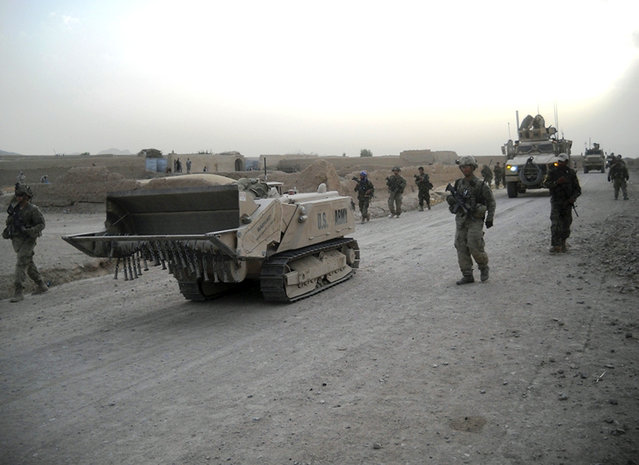
Soldiers with 3rd Brigade, 10th Mountain Division, travel alongside a Doking mine-clearance vehicle in Zharay District, Kandahar province, Afghanistan, during a recent patrol. The Doking is a remote-controlled, unmanned robotic vehicle, used for mine and route clearance. (Photo by U.S. Army via The Atlantic)
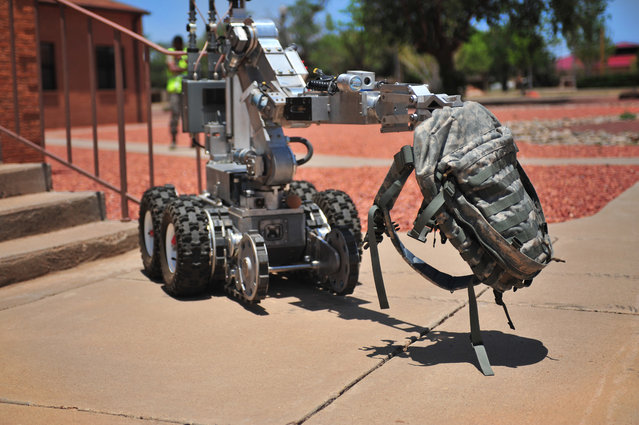
The Andros F6A robot, controlled by U.S. Air Force Explosive Ordinance Disposal team members, carries a backpack containing an improvised explosive device during a hostile threat exercise at Cannon Air Force Base, N.M., June 20, 2012. Air Commandos responded quickly to maintain control of the situation. (U.S. Air Force photo by Airman 1st Class Eboni Reece via The Atlantic)

Akie Koh, a stylist from Japan, makes final preparations on the face of Geminoid F, a female robot, in Hong Kong, on March 28, 2012. The Geminoid F robot, developed by Ishiguro Laboratory in Osaka University and ATR Intelligent Robotics and Communication Laboratories, will be on display with other robots at City Plaza's “Robots in Motion 2012” exhibition from March 29 to April 15. (Photo by Antony Dickson/AFP Photo via The Atlantic)
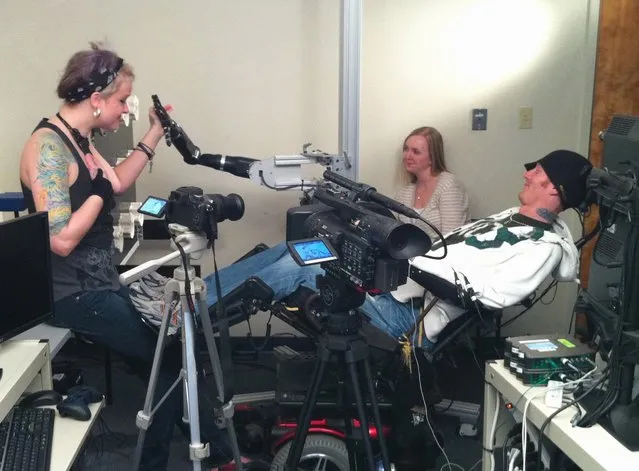
This handout frame grab from video, provided by the University of Pittsburgh Medical Center (UPMC), taken Monday, September 19, 2011, shows quadriplegic research subject Tim Hemmes operating a mechanical prosthetic arm with Katie Schaffer during a testing sessions at a UPMC research facility in Pittsburgh. Hemmes had a chip implanted on the surface of his brain that reads his intention to move his paralyzed arm and sends that instruction instead to an advanced bionic arm. The goal is to create mind-controlled prosthetics to restore some independence to the paralyzed. (Photo by AP Photo/UPMC via The Atlantic)
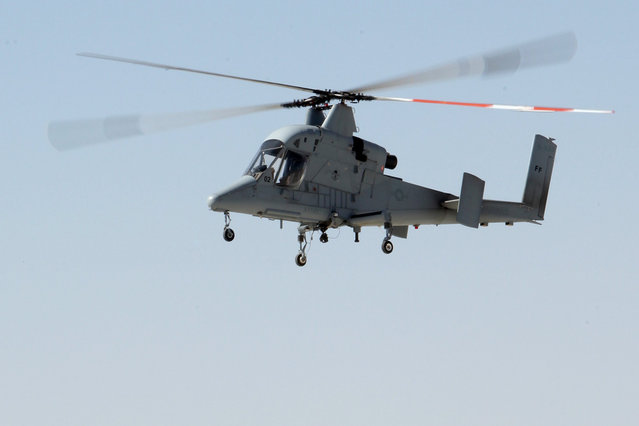
A Kaman K-MAX helicopter, part of a U.S. Marine Corps Cargo Resupply Unmanned Aircraft System (CRUAS) lands at Camp Bastion, Helmand Province, Afghanistan, on October 13, 2012. (Photo by Sgt. Keonaona C. Paulo/USMC via The Atlantic)
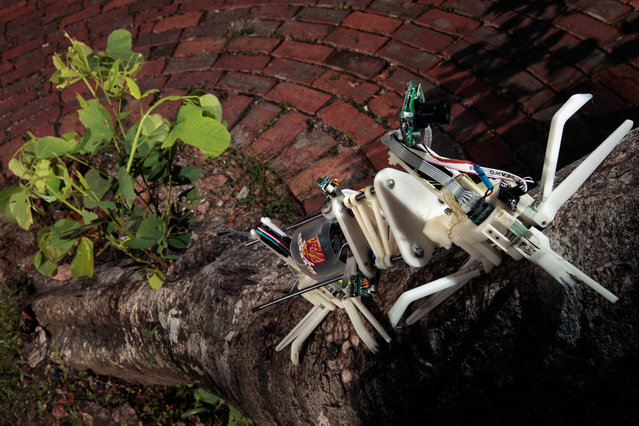
A robot named “Treebot”, developed by the Chinese University of Hong Kong, climbs up a tree in Hong Kong, on June 20, 2011. Treebot has two grippers that dig into bark and allow the device to wriggle up a tree like a caterpillar. It weighs less than 1 kg (2.2 lbs), can carry a camera and is designed to climb trees in place of humans, to perform health checks, reported the South China Morning Post. (Photo by Tyrone Siu/Reuters via The Atlantic)
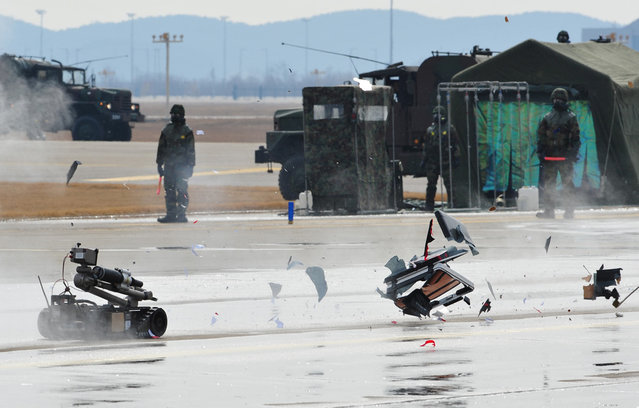
An armed robot controlled by South Korean commandos destroys a mockup of a bomb during an anti-terror drill at Incheon International Airport, west of Seoul, on February 29, 2012. (Photo by Kim Jae-Hwan/AFP Photo via The Atlantic)
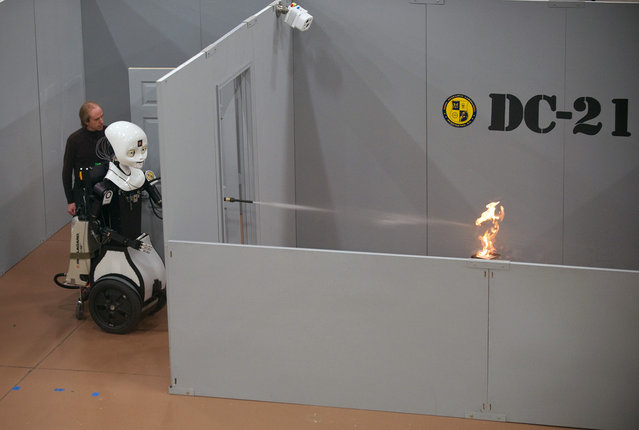
Octavia, a mobile, dexterous, social (MDS) robot, puts out a fire in the prototyping high bay of the just-opened Laboratory for Autonomous Systems Research at the Naval Research Laboratory in Washington, D.C. The LASR facility will integrate science and technology components into research prototype systems and will become the nerve center for basic research that supports autonomous systems research for the Navy and Marine Corps. (Photo by John Williams/U.S. Navy via The Atlantic)
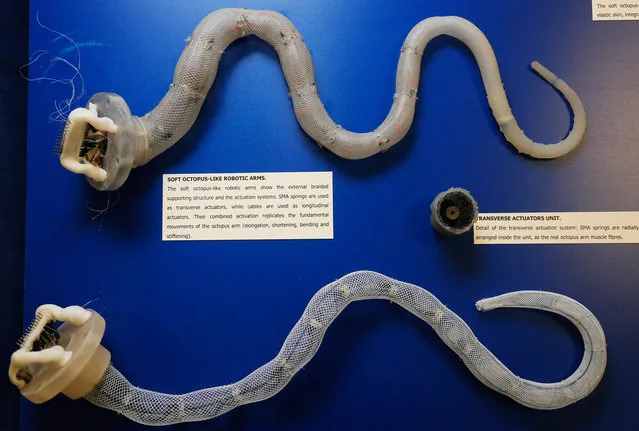
Two Soft Octopus-like Robot arms, photographed at the Institute of Biorobotics of the Italian University Sant'Anna School in Pisa, on July 17, 2012. The Graduate School Sant'Anna of Pisa (SSSA), which includes six research institutes, has developed two prototype bionic arms, a robot capable of overcoming obstacles, another that recycles garbage, and one that has the form of an octopus. (Photo by Fabio Muzzi/AFP Photo via The Atlantic)
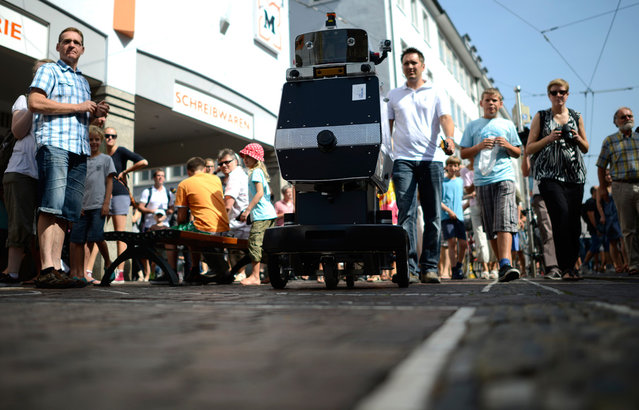
The robot “Obelix” runs through Freiburg city center, on August 21, 2012. The machine, starting 9:45 in the morning at the University of Freiburg, found its way independently to a plaza in the center of Freiburg, about four kilometers away. Obelix made the journey, avoiding people and obstacles, in about 100 minutes. (Photo by Daniel Kopatsch/AP Photo via The Atlantic)
20 Oct 2012 10:30:00,
post received
0 comments
